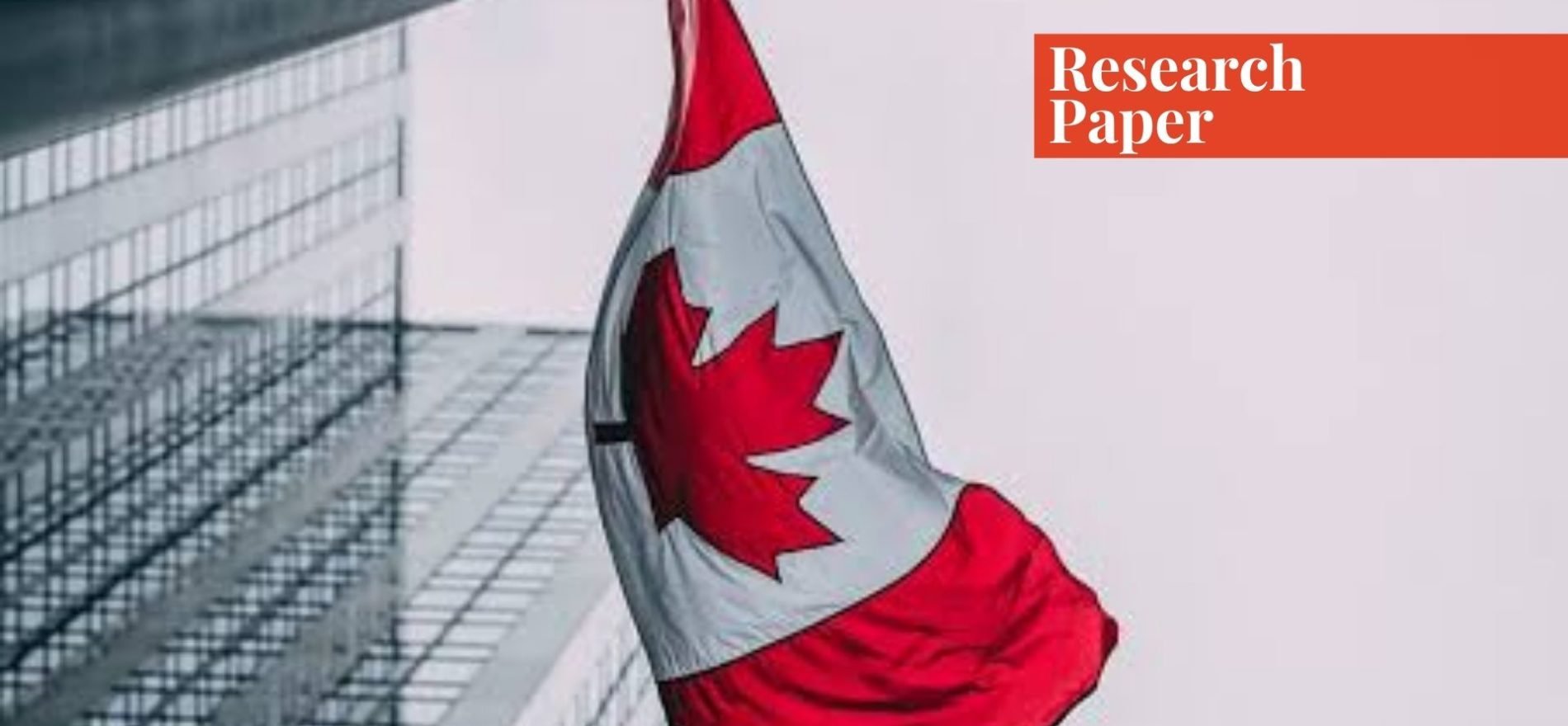Hurain Sheikh is a Pakistan-born Canadian. She has international work experience in West Canada, Dubai, and Islamabad. She is currently refining her experience by pursuing a degree in political science.
Introduction
Canada follows the British parliamentary (Westminster) system due to its roots in the English tradition. As a representative democracy, Canada elects government representatives that form and manage legislation and govern the nation based on the interests of its people (Sharif, 2024). This makes the study of the party system in Canada important as political parties hold a great deal of power in the government. Currently, there are five major national parties: the Liberal Party, the Conservative Party of Canada (CPC), the New Democratic Party (NDP), the Bloc Québécois, and the Green Party of Canada.
A particularity of the Canadian party system is its deviation from Duverger’s law. As per Duverger’s law, political systems that favor plurality/majority rule such as Canada generally lean towards a two-party system. However, as we note through the number of current official parties, Canada is a multiparty system. This has also led a more recent scholar, Richard Johnston, to categorize the party system in Canada as a polarized pluralism. Not only is Canada an exceptional case to Duverger’s law, but I argue that Canada is a moderate pluralistic system.
In order to understand the Canadian case of exceptionalism, we will first undergo the definition and aspects of party systems, then observe the historical development of the party system in Canada and, finally, the impact of the first-past-the-post (FPTP) system on the number of parties and their organizational structure.
Electoral Systems & Party Systems
Generally, countries possess a diverse number of political parties, and patterns of party politics referred to as party systems. As per Sartori, the number of political parties make up the “system” and comprise the interaction between parties due to inter-party electoral competition (Nwokora and Pelizzo, 2017).
Duverger’s Classification
First theorized by Duverger, the classification of party systems can either be a two-party or a multi-party system. He stated that the principal criterion for this classification was the number of parties that was reflected by the electoral system resulting in two-party systems or multiparty systems (Riker, 1982,).
The electoral system is the way in which votes are translated into seats through the electoral formula, district magnitude, and electoral threshold. Duverger’s findings on the correlation between the number of parties and the electoral system strengthened as a “law,” stating that those electoral systems based on a single-member plurality (SMP) lean toward two-party systems. This was further demonstrated by the “mechanical” and “psychological” effects of SMP (Schlesinger and Schlesinger, 2006).
The mechanical effect concerned how votes were translated into seats by the over-representation of the winning parties which in turn affected voter behavior. The psychological effect was the idea that considering the mechanical effects of SMP, voters tended to vote for the two popular parties so as to not waste their vote on the less popular “third” party (Schlesinger and Schlesinger, 2006).
In contrast, Duverger hypothesized that the proportional representation electoral system tended towards multiparty systems due to several winners from each district. Duverger’s law was then further developed by Jean Blondel who further distinguished between the two-party and multi-party system models.
Blondel’s Classification
For Blondel, Western party systems did not fit perfectly into the two-party or multi-party category, rather there were some variations that he identified as two-and-a-half party systems (i.e. Canada) and multi-party systems with a dominant party (i.e. Sweden) (Blondel, 1968). His study presented four different party systems using the average share of the vote won by the largest two parties and then considered the ratio of the first party’s share to the second party and third parties. His findings are presented in the table below:
| Party System | Average Two-Party Vote Share (1945-56) | Country |
| Two-party system | 90% and above | United States |
| Two-and-a-half system: 2 parties, 1 smaller party | 75%-80% | Canada |
| Multiparty system with dominant party: 4-6 parties with 1 major party | 2 parties receive between 62%-66% vote share 1 party receives 40% | Sweden |
| Multiparty system: 4-6 parties | 50% or below | Switzerland |
After Blondel’s classification came Giovanni Sartori’s study of party systems that was centered on the number of parties and the degree of fragmentation. Moreover, it addressed the ideological distance between the parties and the degree of polarization (Nwokora and Pelizzo, 2017). This meant that a higher number of political parties depicted a higher degree of fragmentation. The farther apart the parties were on the left-right ideological scale suggested a higher degree of polarization of the party system.
This resulted in Sartori’s classification of four-party systems: a predominant-party system with one relevant party, a two-party system with two relevant parties, moderate pluralism with three-four relevant parties, and polarized pluralism with five or more relevant parties (Wolinetz, 2004). Another factor to take note of was Sartori’s rules for counting parties based on coalition potential or blackmail potential.
Therefore, there is much variation in how to classify party systems. However, the most agreed criterion for classifying party systems is the number of parties participating in the electoral competition. Another key aspect to consider in terms of party systems is the degree of institutionalization. This is important as well-institutionalized party systems are a component of a well-functioning democracy and democratic consolidation (Mainwaring, 1968).
Contrastingly, those party systems that depict low levels of institutionalization can suggest corruption where political actors pursue their own objectives and are less accountable to the electorate. The institutionalization of party systems also incorporates electoral volatility. Electoral volatility measures the change in voting behavior during each election.
For example, low electoral volatility depicts the ability of political parties in forming positive long-term relationships with citizens, which then leads to better accountability towards the citizen (Mainwaring, 1968). Well-institutionalized party systems depict stable interparty competition with low levels of electoral volatility while weak institutionalized party systems depict high levels of volatility.
This is important to consider as in the case of the Canadian system during the 1993 election, Manwaring and Scully state that Canada depicted weak institutionalization due to high levels of electoral volatility for a long-standing democracy (Mainwaring, 1968). However, aside from this, Canada is generally considered a well-institutionalized party system.
Historical Evolution of the Party System in Canada
To preface, the history of Canadian political parties can be noted as a struggle to establish national unity due to the presence of cultural and geographic variation between the provinces. The Western provinces have felt “alienated” compared to the Eastern provinces – Ontario and Quebec. Quebec tends to isolate itself linguistically and culturally due to its French history, and the maritime provinces are considerably poor compared to the rest of Canada (Uslaner, 2000).
Therefore, only in its early history was Canada characterized as a two-party system with the Liberal (center-left party) and the Conservative parties (center-right party) being dominant. In the 1920s-1930s, however, the Canadian system shifted from a two-party system to a two-and-a-half party system with the rise of The Progressive Party – a farmers’ protest party for free trade – the Social Credit due to populism, and the Cooperative Commonwealth Federation (present-day NDP) – a coalition of socialists, farmers, and unionists (Christian and Jansen, 2006).
These new parties may have emerged on the national scene but were considerably smaller parties compared to the Liberals (“natural governing” party) with 40% of popular support, the Conservatives as the mainline opposition, and the CCF as the third party from 1935 to 1957 (Gagnon and Tanguay, 2017).
In the late 1950s, the Liberal dominance had ended by the Progressive Conservatives (PC) under Diefenbaker by appealing to Quebec. However, the Liberal Party retained its leading position and continuously formed minority and majority governments by relying on “French-speaking and Catholic voters” from 1963 to 1984 (Gagnon and Tanguay, 2017). Another shift that had occurred was the CCF merger with labor groups to rebrand itself as a more moderate left-wing party, the New Democratic Party.
During this period, the party system in Canada settled around the Liberals and the PCs as the two main parties and the NDP as the much smaller relevant party. This was becau74. While the PC became the dominant party of the West, it was able to capture Quebec and become the governing party from 1984 to 1993 (Gagnon and Tanguay, 2017).
In 1993, Canada’s party system experienced another shift due to the collapse of the governing PCs owning to tensions associated with constitutional politics, regionalism, ideological schism (Red Tories vs Blue Tories), and public skepticism. This led to the return of the Liberals to power and the emergence of two new regional ideological parties—the Reform Party (later Canadian Alliance) and the Bloc Québécoisas—as the main opposition (Gagnon and Tanguay, 2017).
The 1993 Canadian election is considered a case of high volatility due to the erosion of support towards both the Liberals and PCs. Moreover, the party system switched to a multiparty system due to the electoral competition between five main political parties: the Liberals with 177 seats, the PCs with 2 seats, the NDP with 9 seats, the Bloc with 54 seats, and the Reform/Alliance with 52 seats (Makarenko, 2010).
However, these changes were temporary as both Reform/Alliance and the Bloc had significant support only in certain provinces (the Alliance in the west and the Bloc in Quebec) but were unappealing in other parts of the nation, leading to their eventual decline. Therefore, the continuous electoral failure of both the Alliance and PC against the Liberals resulted in their merger as the Conservative Party of Canada (CPC) in 2003 (Gagnon and Tanguay, 2017).
From 2003 to 2013, the CPC under Harper’s leadership had not only reduced the governing Liberals to minority status in the 2004 election (135 seats) but also reduced them to third party status by 2011 (34 seats). The CPC’s domination resulted in two minority governments in 2006 (124 seats) and 2008 (143 seats) and a majority in 2011 (166 seats).
Meanwhile, the NDP had become the official opposition in 2011 (103 seats) by gaining support from Quebec. The Bloc was reduced to a mere 4 seats in 2011 and the appearance of the Green Party since 2008 (1 seat). While the Greens were formed in 1983 as a party that was devoted to environmental concerns, they did not gain significant support until 2008 (Gagnon and Tanguay, 2017). This resulted in the Greens going from a one-issue party to a leftist-populist party in order to broaden their electoral appeal.
The party realignment of the 2000s led some scholars to believe that the party system in Canada would return to a two-party system with the CPC as the governing right-centrist party and the NDP as the left-centrist opposition party (Gagnon and Tanguay, 2017). However, after the election of Justin Trudeau as the Liberal leader in 2013, the Liberals were able to return to power with a majority in 2015 (184 seats) and have been continuously governing with a minority in 2019 (157 seats) and 2021 (160 seats).
Consequently, the CPC (99 seats) had become the official opposition, the NDP (44 seats) returned to third party status; the Bloc (10 seats) and Greens (1 seat) became the marginalized minor parties. Therefore, as there were six political parties that participated in the 2021 elections—the Liberals, the CPC, the NDP, the Greens, and the People’s Party (far right-populism)—the present-day Canadian party system is a multiparty system that fits in the moderate pluralistic category due to the continuous domination of the Liberals and Conservatives, followed by the NDP and Bloc as the more influential smaller parties.
Duverger’s Law and Canada’s Party System
This brings us to the exceptional case of the party system in Canada that does not neatly fit within the framework of party systems put forth by previous scholars such as Duverger and Johnston. An earlier scholar who pointed to the exceptional case of the Canadian party system was Alan C. Cairns in “The Electoral System and the Party system, 1921-1965”.
His article provides evidence that is still relevant today of the institutional impact of SMP on the Canadian party system, which intensifies “sectional cleavages” (sectional conflict) within the nation. Doing so deepened the presence of regional divide, and sectional identities, and created regional-based parties (Cairn 1968, 63-66). Generally, SMP is considered to create stable governments compared to the PR system due to limiting the party system to two parties.
In the Canadian context, indeed the electoral system results in the party with the most seats in the House of Commons forming the government, and the party with the second-most seats becoming the official opposition (McCracken, 2020). However, the geographical allocation of seats distorts party representation in parliament due to the tendency of over-awarding some parties with a higher percentage of seats than votes received. Therefore, there have been many instances where majority governments have been formed without securing majority votes.
The presence of disproportionality is also noted as a party may have a large base of support across the country but only represents a small percentage in the House. For example, the emergence of the Quebec-centred Bloc party and its ability to hold many seats in the house is exaggerated due to the FPTP system.
Contrastingly, the West overwhelmingly supported the CPC during the 2019 election but did not result in a majority of seats in the House (McCracken 2020, 17). Therefore, Cairns’ analysis depicts how SMP has a tendency toward assisting regional-based political parties to emerge and political parties to only focus on areas in which they are likely to win. Therefore, the Canadian party system is an exceptional case of Duverger’s two-party system law.
For the sake of our study, the way in which FPTP system distributes votes in a two-member contest, a candidate would gain a clear majority by receiving “50% + 1” of the valid votes cast. When there are three or more candidates contest in an election there is a reduced likelihood of gaining a clear majority (Courtney, 1999). In this case, a plurality (the largest share of votes) is all that would be needed to win the district:
- 50% + 1 in a two-person race
- 33 1/3% + 1 in a three-person race
- 25% + 1 in a four-person race
Johnston’s Study and Canadian Party Organization
Another framework that the Canadian system also diverges from is Sartori’s initial two-party system categorization which was later adapted by Richard Johnston. Essentially, Johnston’s study on the Canadian party system suggested a case of polarized pluralism due to “unhealthy” multiparty competition with high electoral volatility, center party dominance (the Liberal party), and the dynamics of a centrifugal system rather than a centripetal one (Johnston, 2008).
He especially noted this after the elections of 1993 where both Liberals and PCs lost their electoral support to the two new ideological parties at the time, the Reform and Bloc. Ideally, a stable party system’s distribution of ideology and power should be in the center, either moderate left or right. The idea of a centrifugal system suggests the presence of anti-system parties, that are located on the extreme opposing ends of the left-right ideological scale, competing against the parties located in the center (Wolinetz, 2004).
This means that the distribution of the power and influence is concentrated on the left and right ends of the spectrum. In such a system, moderate policies and opinions are replaced by polarized ones which cause dysfunctionality and difficulty to govern as seen during Weimar Republic (Wolinetz, 2004).
Canada’s current party system fits a moderate pluralism model rather than a polarized one as per Sartori’s party system framework. There certainly have been instances of different radical/ideological parties that have emerged such as the Social Credit, CCF/NDP, the Reform/Alliance, and the Bloc. However, these parties were never able to form a government, nor acquire a majority vote due to being viewed as too radical/ideological.
Moreover, in our system, these parties tend to be less influential compared to the big two, even more so compared to the governing party (McCracken, 2020). Most Canadians tend to prefer moderate views on social, economical, and political policies, which is why ideological parties have not been successful. Taking into consideration the data collected from the Canadian Election Studies (CES) from 1997 to 2015, most Canadians placed themselves in the center or slight left-right of the ideological scale (Santos, 2019).
Therefore, if Canada was a case of polarization, we would see the majority placing themselves on the extremes, which would then be reflected by political parties. However, this is not the case and the reason for the success of brokerage parties in the Canadian system, notably the Liberals and Conservatives.
The practice of brokerage politics is the attempt to maximize the electoral appeal by adopting popular, mainstream, and moderate policies that are favorable to the broader spectrum of the population. While ideological parties represent particular groups and promote policies based on strict ideology, brokerage parties organize and operate in a manner that seeks national accommodation through deal-making (Carthy and Cross, 2010).
Moreover, brokerage parties tend to organize around and put emphasis on the leaders, making them the focal point of campaign strategy. This in turn reinforces party loyalty and party discipline (Carthy and Cross, 2010). Historically, Canada’s brokerage parties have sought to appeal to the diverse social groups and reduce inter-regional/inter-linguistic conflicts by forming built-in coalitions within the large parties.
This is not to say that the Liberals and the Conservatives have not tried to appeal to distinct regional or social groups over others (Carthy and Cross 2010, 10). However, they do so by insisting that the national unity of the country requires a party that does not represent one particular group or seeks to divide.
Additionally, the electoral system gives preference to large brokerage parties due to their larger appeal over non-brokerage parties. While smaller parties may exert some influence during minority governments, these situations are less frequent and for shorter durations. As noted previously, SMP tends to promote majority governments and larger parties which shapes party organizations.
While SMP does occasionally allow for regional protest parties to break through by rewarding parties the concentration of votes from a small number of ridings. However, this systematically prevents new national, single-issue, and ideological parties to succeed, which dwindles their support over time. Basically, we indeed have a multi-party system, but the electoral system systematically benefits the brokerage parties over the smaller parties.
Consequently, those parties that were polarizing eventually had to “soften their edges” or merge with the bigger parties in order to appeal to a broader set of voters. For example, the Alliance merger with the PC in 2003, CCF rebranding itself as the more moderate NDP in 1961, and even the Bloc abandoning its separatist views.
All these parties may have emerged on the more extreme ends of the ideological scale but had to gradually move towards the dominant center (Petry and Collette, 2009). The reason for this is to attract the majority of the Canadians who are located in the center and who do not want to waste their vote on smaller parties. Therefore, Canada reflects a centripetal party system and falls under Sartori’s category of moderate pluralism.
Conclusion
As we have seen in this paper, the Canadian party system is an exceptional case of Duverger’s law because the electoral system (FPTP) that gravitates to a two-party system actually encourages other parties to emerge. This is because the way in which votes are distributed in accordance with the geographical allocations of seats allows for smaller parties to emerge. These smaller parties can gain regional-based support which allows them to stay relevant in the electoral competition despite not having much influence.
Contrastingly, the Canadian party system is not a polarized pluralistic system as proposed by Johnston. Our unique electoral system allows for smaller parties to arise but not gain substantial power because Canadians tend to vote for the major brokerage parties given their centrist ideas and policies.
Therefore, even though the Canadian party system has historically had parties at the extremities of the ideological scale, these parties had to evolve over time to appeal more to the majority which held more centrist ideological views. If Canada were indeed a polarized pluralistic system, we would witness a lot more instability with respect to the implementation of policies.
Since the FPTP system only allows one party to hold a majority government, this type of instability is fairly negligible. It is for this reason I argue that our Canadian party system is in actuality a moderate pluralistic system as opposed to the one hypothesized by Duverger or Johnston.
References
- Blondel, J. (1968). Party Systems and Patterns of Government in Western Democracies. Canadian Journal of Political Science, 1(2), 180-203. https://doi.org/10.1017/s0008423900036507.
- Cairns, A. (1968). The Electoral System and the Party System in Canada, 1921–1965. Canadian Journal of Political Science, 1(1), 55-80. https://doi.org/10.1017/s0008423900035228.
- Courtney, J. C. (1999, April 23). Plurality-Majority Electoral Systems: A Review. Elections Canada.
- Carty, R. K., & Cross, W. (2010, April 8). Political parties and the practice of brokerage politics. Oxford Handbooks Online. https://doi.org/10.1093/oxfordhb/9780195335354.003.0011.
- Christian, W., & Jansen, H. (2006, February 7). Canadian Party system. The Canadian Encyclopedia.
- Gagnon, A. G., & Tanguay, B. (2017). Canadian parties in transition: Discourse, organization, and representation. University of Toronto Press.
- Johnston, R. (2008). Polarized Pluralism in the Canadian Party System: Presidential Address to the Canadian Political Science Association, June 5, 2008. Canadian Journal of Political Science, 41(4), 815-834. https://doi.org/10.1017/s0008423908081110.
- Makarenko, J. (2021, August 4). Political parties and the Party System in Canada. Repolitics. https://repolitics.com/features/political-parties-and-the-party-system-in-canada/.
- McCracken, D. J. (2020, May 1). Tailor-made for Canada: Why Canadian federal elections should adopt a mixed-member proportional system. Federalism-E.
- Nwokora, Z., & Pelizzo, R. (2017). Measuring Party System Change: A systems perspective. Political Studies, 66(1), 100–118. https://doi.org/10.1177/0032321717710568
- Petry, F., & Collette, B. (2009). “Estimating the Policy Positions of Canadian Political Parties from Legislative Election Manifestos 1968-2008.”
- Riker, W. (1982). The Two-party System and Duverger’s Law: An Essay on the History of Political Science. American Political Science Review, 76(4), 753-766. https://doi.org/10.2307/1962968.
- Santos, J. (2019, October 17). When it comes to politics, it’s not disagreeing that’s the problem – it’s that we like each other less. CBC News. https://www.cbc.ca/news/canada/calgary/polarization-politics-canada-election-john-santos-1.5322631.
- Schlesinger, J. A., & Schlesinger, M. S. (2006). Maurice Duverger and the study of political parties. French Politics, 4(1), 58–68. https://doi.org/10.1057/palgrave.fp.8200085
- Sharif, M. H. (2024, April 26). Democracy is for the people by the people. Paradigm Shift. https://www.paradigmshift.com.pk/democracy-is-for-the-people-by-the-people/
- Uslaner, Eric. (2000). “Strong Institutions, Weak Parties: The Paradox of Canadian Political Parties.” https://www.researchgate.net/publication/228963315_Strong_Institutions_Weak_Parties_The_Paradox_of_Canadian_Political_Parties.
- Wolinetz, Steven. “Classifying Party Systems: Where Have All the Typologies Gone.” Wolinetz, S. (2014, May 24). Classifying party systems: Where have all the typologies gone. Academia.https://www.academia.edu/4226966/Classifying_Party_Systems_Where_Have_All_the_Typologies_Gone.
If you want to submit your articles, research papers, and book reviews, please check the Submissions page.
The views and opinions expressed in this article/paper are the author’s own and do not necessarily reflect the editorial position of Paradigm Shift.



















